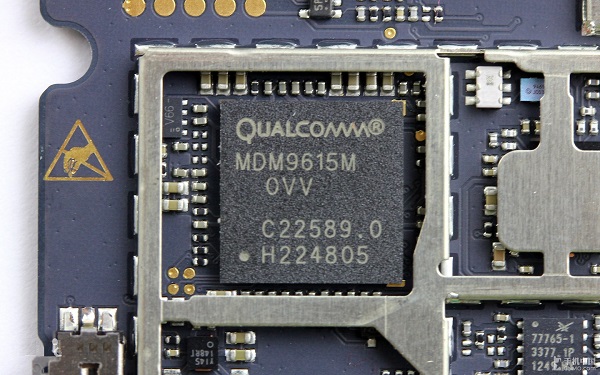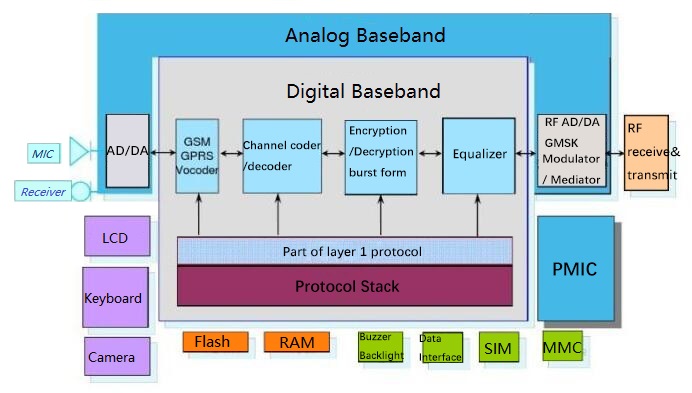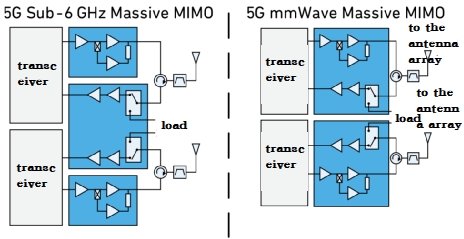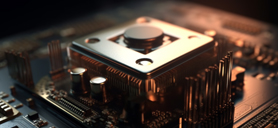What is a Baseband Processor?
5/8/2023 10:57:48 AM
Ⅰ Overview
The baseband processor synthesizes the baseband signal that is about to be transmitted and decodes the received baseband signal. When transmitting a baseband signal, it compiles the audio signal into a baseband code; when receiving a signal, it decodes the baseband code into an audio signal. At the same time, the baseband processor is also responsible for compiling address information, text information, picture information, etc.
A baseband processor is a kind of SOC with complex integration. Mainstream baseband processors support multiple network standards, i.e., all mobile and wireless network standards are supported on one baseband processor, including 2G, 3G, 4G, and WiFi, etc. Multi-mode mobile terminals can realize seamless roaming between multiple mobiles and wireless networks around the world. The basic structure of most current baseband processors is a microprocessor and a digital signal processor. The microprocessoris the control center of the entire chip, mostly using ARM cores, while the DSP subsystem is responsible for baseband processing.

baseband processor
The baseband processor present in a smartphone can be understood as a complex SoC chip with a variety of functions, and the normal operation of each function is configured and coordinated through the microprocessor. This complex chip is centered on the ARM microprocessor, which controls and configures each peripheral function module around the ARM microprocessor through the ARM microprocessor's dedicated bus (AHB bus), which mainly includes GSM, WiFi, GPS, Bluetooth, DSP, and memory, etc... Each function module has its own memory and address space. Their functions are independent of each other. The baseband processor itself has a power management chip.
Ⅱ Baseband processor components

Figure: baseband processor structure diagram
The baseband processor can be divided into five sub-blocks: CPU processor, channel coder, digital signal processor, modem, and interface module.
CPU processor: control and management of the whole mobile station, including timing control, digital system control, RF control, power saving control, and human-machine interface control. If frequency hopping is used, it should also include the control of frequency hopping. At the same time, the CPU processor performs all software functions of the GSM terminal, i.e. layer1 (physical layer), layer2 (data link layer), layer3 (network layer), MMI (human-machine interface), and application layer software of the GSM communication protocol.
Channel coder: mainly completes the channel coding and encryption of service and control information, including convolutional coding, FIRE code, parity check code, interleaving, burst pulse formatting.
Digital signal processor: mainly completes the channel equalization using Viterbi algorithm and the voice coding/decoding based on the regular pulse excitation-long-term prediction technique (RPE-LPC).
Modem: mainly completes the Gaussian Minimum Shift Keying (GMSK) modulation/demodulation required by the GSM system.
Interface module: including three sub-blocks: analog interface, digital interface, and human-machine interface.
What network standard the mobile terminal supports is determined by the baseband processor mode, while what frequency band it supports is determined by the antenna and RF module. The baseband processor completes the access function of the mobile terminal. The current baseband processor is a highly complex system-on-chip (SoC), which not only supports several communication standards (including GSM, CDMA 1x, CDMA2000, WCDMA, HSPA, LTE, etc.), but also provides multimedia functions and interfaces related to multimedia displays, image sensors, and audio devices. To further simplify the design, the power management circuits required for these compiled circuits are increasingly integrated into them.
Ⅲ Baseband processor SOC architecture
Baseband digital processing functions and the basic peripheral functions of cell phones are concentrated in a single system on chip (SOC), whose basic architecture uses a microprocessor + digital signal processor (DSP) structure, and the processing power of the microprocessor and DSP has been enhanced.
1. The microprocessor is the control center of the whole chip and will run a real-time embedded operating system (such as Nucleus PLUS).
2. The DSP subsystem is the focus of the baseband processing, which contains many hardware gas pedals and baseband-specific processing modules that perform all physical layer functions.
With the development of real-time digital signal processing technology, ARM microprocessor (different micro-series will be used, 3G chips mostly use ARM9), DSP, and FPGA architecture become the main way of mobile terminal baseband processors.
Ⅳ Baseband processor ARM architecture
In the field of chip architecture, X86 and ARM can be said to have been competing for decades and have occupied an unshakable position in their respective fields. Among them, X86 dominates the PC chip market, while ARM dominates the mobile terminal chip market. Because of the low cost, low power consumption, and high efficiency, the ARM architecture has catered to the development trend of many mobile terminal devices including smartphones.
The following figure shows the logic architecture of a typical ARM-based baseband processor, where 3G/4G Baseband Logic refers to the DSP computing subsystem.

Figure: baseband processor framework on a typical ARM architecture
1 The microprocessor completes multitasking scheduling, inter-task communication, peripheral drivers, and communication between the microprocessor and the DSP subsystem and other modules, etc. through the real-time operating system RTOS (e.g. Nucleus PLUS).
Functions also include:
(1) control and management of the entire mobile station, including timing control, digital system control, RF control, power saving control, etc.;
(2) complete all software functions, i.e., communication between the physical layer and protocol stack of wireless communication protocols, high-level protocol stack (TCP/IP, etc.), and if used in a functional machine, it will also include MMI (human-computer interaction interface) and application software.
2 The DSP subsystem is used for processing all algorithms of the physical layer, including channel coding, encryption, channel equalization, voice coding/decoding, modulation, and demodulation, etc. The means of data communication between the DSP subsystem and the microprocessor subsystem include dual-port random read memory (RAM), multi-bus shared resources (some vendors use AMBA's multi-layer bus protocol), etc. The multimode multi-frequency baseband processor may contain multiple DSPs.
3 In terms of memory organization, both the microprocessor and DSP subsystem may have their own independent cache with shared on-chip SRAM and shared external expansion memory. The extended memory commonly supports synchronous dynamic random memory (SDRAM) and NAND-type Flash RAM, etc.
FLASH ROM can be used to store Boot Rom and CP Rom for linking OS and user applications. ROM interface is mainly used to connect FLASH ROM for storing programs, and RAM interface is mainly used to connect static RAM (SRAM) for storing temporary data. On-chip embedded large-capacity static random read memory (SRAM) has become very common, which is conducive to reducing power consumption and reducing system costs.
4 In terms of peripherals and interfaces, the baseband processor often supports a variety of interfaces to facilitate communication with the application processor and the addition of other modules such as Wifi, GPS. Interfaces include UART, multimedia interface (MMI), universal serial bus (USB), SPI, etc..
MCU communication with external interfaces can be done through DMA, and if the baseband processor does not integrate RF, there is also a dedicated RF interface.
Conclusion
We generally think that the performance of the cell phone CPU is reflected in its processing speed and power consumption. In fact, in the era of smartphones, there is a layer of the most basic and critical needs - cell phone signal quality. This communication function determined by the baseband processor will directly affect the quality of cell phone calls and Internet speed.
With the advent of the 5G network and 5G cell phones, the rapid capture of the 5G baseband processor market share will help the chip giants to improve financial revenue in order to gain a head start in the 6G network and form a virtuous circle.
Recommended News
-
Tel
0755-23616330 -
Whatsapp

 English
English
 English
English 简体中文
简体中文 Russia
Russia
 2023-05-08
2023-05-08


